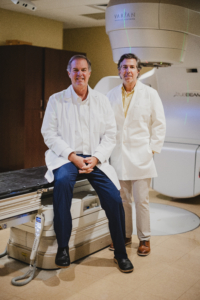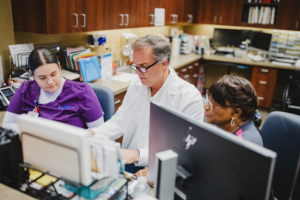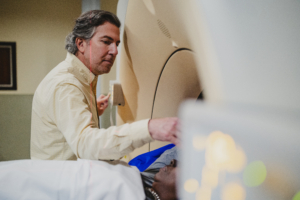When You Need Science and Compassion: A New Era of Cancer Care in Radiation Oncology

High-quality radiation oncology plays a crucial role in modern cancer treatment. Now, thanks to recent technological advances, radiation therapy is more effective, safer and has a faster recovery time. It can also be used to treat conditions beyond cancer. Discover more about what radiation oncology is, how it works and the variety of ways it can be used to care for patients at the Harbin Clinic Cancer Center.

How Radiation Therapy Works
Radiation oncology is a medical specialty using forms of radiation to destroy genetic material within cancer cells, preventing them from growing and dividing. Unlike normal cells that can easily repair themselves, cancer cells lose the ability to repair minimal damage, making them vulnerable to radiation. This treatment is one of the three major anti-cancer tools, alongside surgery and systemic therapies like chemotherapy.
Guiding Questions in Cancer Care
With nearly 20 and 30 years of care experience, Harbin Clinic radiation oncologists Dr. J.C. Abdou and Dr. Matthew Mumber share how physicians at the Harbin Clinic Cancer Center think about the best treatment for patients, including how they decide whether radiation therapy is right for a situation.

“In cancer care, we consider multiple factors to determine the best care possible. First, we start with identifying the type of cancer. Then, we consider where it is in the body and if it has spread. Finally, we think through the best treatment options, usually with multidisciplinary input and utilizing National Comprehensive Cancer Network evidence-based treatment guidelines,” said Dr. Abdou.
“Thinking through each of these scenarios guides the treatment plan, which may include directly fighting cancer with surgery, chemotherapy, radiation or a combination of these,” said Dr. Mumber. “Additionally, our medical professionals are making sure patients have supportive care interventions to help them access and tolerate treatments, as well as reduce cancer recurrence.”
Radiation Therapy at the Harbin Clinic Cancer Center

Accredited by the American College of Radiation (ACR) and certified by certified by the Commission on Cancer for Optimal Cancer Care Resources (COC), Harbin Clinic Radiation Oncology is committed to providing expert cancer care to the Northwest Georgia community. This team works tirelessly to implement care that is both integrative and multidisciplinary.
“We are dedicated to whole system care,” said Dr. Mumber, who is also board-certified in integrative oncology as well as radiation oncology. “We are meeting the needs of the patient at every touch point. Along with anti-cancer care, we have a strong support team considering every facet of a person’s well-being including diet, exercise, stress management, caring for caregivers and more.”
Describing how their care is multidisciplinary, Dr. Abdou said, “We are constantly having discussions with referring physicians and specialists who may need to be involved as a team member in a patient’s care. Local pathologists, radiologists, medical oncologists, radiation oncologists, surgeons and patient navigators meet and participate in a weekly conference where we present patient situations and consider places where we can improve care processes. Our collaboration with Atrium Health Floyd will further enhance our ability to deliver state of the art, evidence-based cancer care in our community.”
Recent Advances in Radiation Oncology
Thanks to recent technological advancements, Dr. Mumber and Dr. Abdou have continued to implement the most advanced care possible at the Harbin Clinic Cancer Center. Now, advanced computer techniques have enhanced oncologists’ ability to directly visualize tumors in the body while a patient lies on the treatment table. This high level of precision ensures the treatment is even more precise, allowing for dosage increases to tumors while sparing surrounding healthy tissue. These breakthroughs also result in shorter treatment plans and significantly improved patient tolerance to the therapy.

For example, stereotactic body radiation therapy (SBRT) may be used to treat early-stage lung cancers as an alternative to surgery in medically inoperable patients. This treatment uses precisely focused radiation to treat the tumor rather than removing the entire lung lobe with surgery. SBRT is delivered over one week and is well-tolerated, with most patients reporting no significant side effects.
Skin Cancer
For early-stage biopsy proven non-melanomatous skin cancers, which happen to be the most common cancer of all, radiation therapy offers equivalent cure rates as surgery without the cutting and the possible need for skin grafting and associated cosmetic concerns. Harbin Clinic Radiation Oncology is the only ACR certified facility in the region, ensuring quality radiation treatment delivery.
Low Dose Radiation Therapy
Beyond traditional radiation oncology treatment, there are also certain cases where low dose radiation therapy (LDRT) can provide pain relief for patients who are not surgical candidates. Pain associated with conditions like refractory osteoarthritis and plantar fasciitis may benefit from radiation therapy when other first line treatments have been unsuccessful and surgery is not the right care plan for a patient. Multidisciplinary care ensures proper treatment selection for an individual.

For example, LDRT slows or halts the progression of osteoarthritis, now known to be the fastest increasing health condition and the second leading cause of disability in the United States. Treatment may include affected hands, wrists, shoulders, ankles, knees, hips and the spine.
Standard management for early osteoarthritis includes education, exercise, weight loss and pain relievers. Rather than masking the symptoms, like a pain-relieving pill would, a dose of radiation directed at the site of osteoarthritis can decrease the body’s production of inflammation in that area.
Low dose radiation has a powerful anti-inflammatory effect and has virtually no side effects. Some patients experience pain relief and improved mobility shortly after treatment, and that pain relief can last up to three years.


